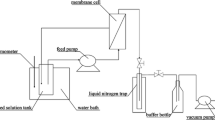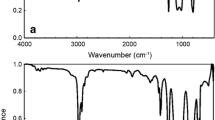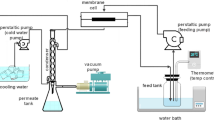Abstract
In further purification of ethyl acetate (EAC) process, azeotropic distillation or extractive distillation is usually applied. High energy consumption limits the economic profit of the process. In this study, pervaporation separation of EAC/ethanol (EA)/water ternary mixtures using the ceramic-supported polyvinyl alcohol (PVA) composite membrane was investigated to substitute the azeotropic distillation or extractive distillation. Swelling experiments were performed to evaluate the sorption characteristic of the membrane. Flory-Huggins theory was applied to study the interaction between the membrane and the penetrant. The UNIFAC model was adopted to investigate the variation of the penetrant activity in the membrane. The effects of operation temperature, feed water content and feed flow rate on the PV performance of the membrane were systematically investigated. The composite membrane exhibited high PV performance with the total flux of 2.1 kg·m−2·h−1 and 94.9 wt% permeate concentration of water (operation condition: feed composition 82.6 wt% EAC, 8.4 wt% EA, 9 wt% water, feed temperature 60 °C, feed flow rate 252 mL· min−1). The PV performance of the membrane varied slightly over a continuous PV experiment period of 110 h. Our results demonstrated that the PVA/ceramic membrane was a potential candidate for the purification of EAC/EA/water ternary mixtures.
Similar content being viewed by others
References
P. Dutia, Chemical Weekly-Bombay-., 49, 176 (2004).
A. Szanyi, P. Mizsey and Z. Fonyo, Ind. Eng. Chem. Res., 43, 8269 (2004).
X. Feng and R. Y. M. Huang, Ind. Eng. Chem. Res., 36, 1048 (1997).
P. D. Chapman, X. Y. Tan, A. G. Livingston, K. Li and T. Oliveira, J. Membr. Sci., 268, 13 (2006).
S. Sommer and T. Melin, Chem. Eng. Process., 44, 1138 (2005).
D. A. Devi, B. Smitha, S. Sridhar, S. S. Jawalkar and T. M. Aminabhavi, J. Chem. Technol. Biotechnol., 82, 993 (2007).
K. S. Chang, Y. H. Huang, K.R. Lee and K. L. Tung, J. Membr. Sci., 354, 93 (2010).
Z. M. Mao, Y. M. Cao, X. M. Jie, G. D. Kang, M. Q. Zhou and Q. Yuan, Sep. Purif. Technol., 72, 28 (2010).
L. Y. Jiang, T. S. Chung and R. Rajagopalan, AIChE J., 53, 1745 (2007).
J. H. Chang, J. K. Yoo, S. H. Ahn, K. H. Lee and S.M. Ko, Korean J. Chem. Eng., 15, 28 (1998).
H. S. Choi, S. D. Hong, G. J. Hwang, C. S. Park, K. K. Bae and K. Onuki, Korean J. Chem. Eng., 23, 288 (2006).
H. H. Nguyen, N. Jang and S. H. Choi, Korean J. Chem. Eng., 26, 1 (2009).
Y. Salt, A. Hasanoğlu, İ. Salt, S. Keleşer, S. Özkan and S. Dinçr, Vacuum., 79, 215 (2005).
H. I. Shaban, J. Appl. Polym. Sci., 70, 2361 (1998).
H. K. Yuan, Z. L. Xu, J. H. Shi and X. H. Ma, J. Appl. Polym. Sci., 109, 4025 (2008).
D. A. Devi, K. V. S. N. Raju and T. M. Aminabhavi, J. Appl. Polym. Sci., 103, 3405 (2007).
Y. X. Zhu, S. S. Xia, G. P. Liu and W. Q. Jin, J. Membr. Sci., 349, 341 (2010).
X. H. Zhang, Q. L. Liu, Y. Xiong, A. M. Zhu, Y. Chen and Q. G. Zhang, J. Membr. Sci., 327, 274 (2009).
S. S. Xia, X. L. Dong, Y. X. Zhu, W. Wei, F. J. Xiangli and W. Q. Jin, Sep. Purif. Technol., 77, 53 (2011).
J. G. Wijmans and R. W. Baker, J. Membr. Sci., 107, 1 (1995).
T. Oishi and J. M. Prausnitz, Ind. Eng. Chem. Process Des. Dev., 17, 333 (1978).
A. Fredenslund, J. Gmehling and P. Rasmussen, Vapour-Liquid Equilibria Using UNIFAC, Elsevier Science Publishers B V, Amsterdam (1977).
F. J. Xiangli, Y. W. Chen, W. Q. Jin and N. P. Xu, Ind. Eng. Chem. Res., 46, 2224 (2007).
M. H. V. Mulder and C. A. Smolders, J. Membr. Sci., 17, 289 (1984).
K. S. Chang, C. C. Hsiung, C. C. Lin and K. L. Tung, J. Phys. Chem. B., 113, 10159 (2009).
Author information
Authors and Affiliations
Corresponding author
Rights and permissions
About this article
Cite this article
Xia, S., Wei, W., Liu, G. et al. Pervaporation properties of polyvinyl alcohol/ceramic composite membrane for separation of ethyl acetate/ethanol/water ternary mixtures. Korean J. Chem. Eng. 29, 228–234 (2012). https://doi.org/10.1007/s11814-011-0154-x
Received:
Accepted:
Published:
Issue Date:
DOI: https://doi.org/10.1007/s11814-011-0154-x




